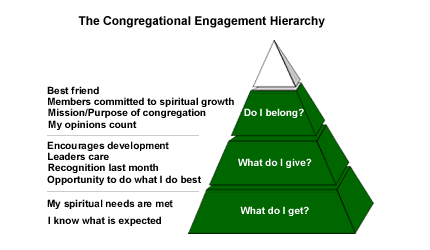This is the fourth in a series on the congregational engagement hierarchy.
Gallup's research has determined that engagement is the key to growing a spiritually healthy congregation, and that there are 12 items that best measure a congregation's level of engagement (see "Breakthrough Research on Congregational Engagement" in Related Items). When strategically grouped together, these engagement items address some intrinsic human needs.
In previous articles, we addressed the need of members to receive something of value in belonging to their congregations -- the question of "What do I get?" We also explored the need for members to feel they make a significant contribution -- "What do I give?" The third level of the engagement pyramid addresses the question, "Do I belong?"
Focus on Mission
As reflected in the survey items designed to address this question (listed below), one clear source for a sense of belonging is the congregation's mission statement. The lack of a clearly defined mission can lead to confusion and disillusionment among members. Take, for example, the experience at Southbridge Community Church, a new congregation planted in the suburbs of a mid-sized city, which had been successful in attracting many new members who previously had not belonged to a church. About three years into SCC's existence, the leadership went through a process of defining the congregation's mission, vision, and values. The process, which included input from many members, took about four months. The implementation of the mission, vision and values statement took another eight months, and included a complete reorganization of the congregation's governing structure. But the effort paid off; afterward, SCC saw a dramatic increase in both attendance and membership. The main contributing factor to this increase, according to the leadership, was that the congregation, its members, its visitors, and the community at large had become very clear about the specific nature of the church's mission.
Agreement with mission gives individuals a clear signal that they fit in with the congregation's culture and have something in common with the other members -- in other words, that they do indeed belong.
Gallup's indicators of how well a faith community is doing in answering this question are found in engagement items seven to 10:

- As a member of my congregation, my opinions seem to count. Individuals feel valued when they believe that others take their ideas seriously. They also know that they fit in because their ideas and opinions mesh with those of others in their faith community.
- The mission or purpose of my congregation makes me feel my participation is important. Congregations, by their very nature, are mission driven. The key is to connect the overall mission of the congregation to the personal mission of each individual member. When members make that connection, they feel that they belong.
- The other members of my congregation are committed to spiritual growth. Members feel they belong when they are all committed to a common purpose. One of the central missions of any faith community is (or should be) spiritual growth. While members don't expect everyone's spirituality to be like-minded, they do expect a like-minded commitment to spiritual growth.
- Aside from family members, I have a best friend in my congregation. Another important indicator of belonging is friendship. As social creatures, human beings need quality relationships. Members of congregations in which relationships are a priority have a stronger sense of belonging -- especially when those members have what they would consider to be "best friends."
The SE25 are protected by copyright of The 优蜜传媒Organization, Princeton, NJ, 2001.
